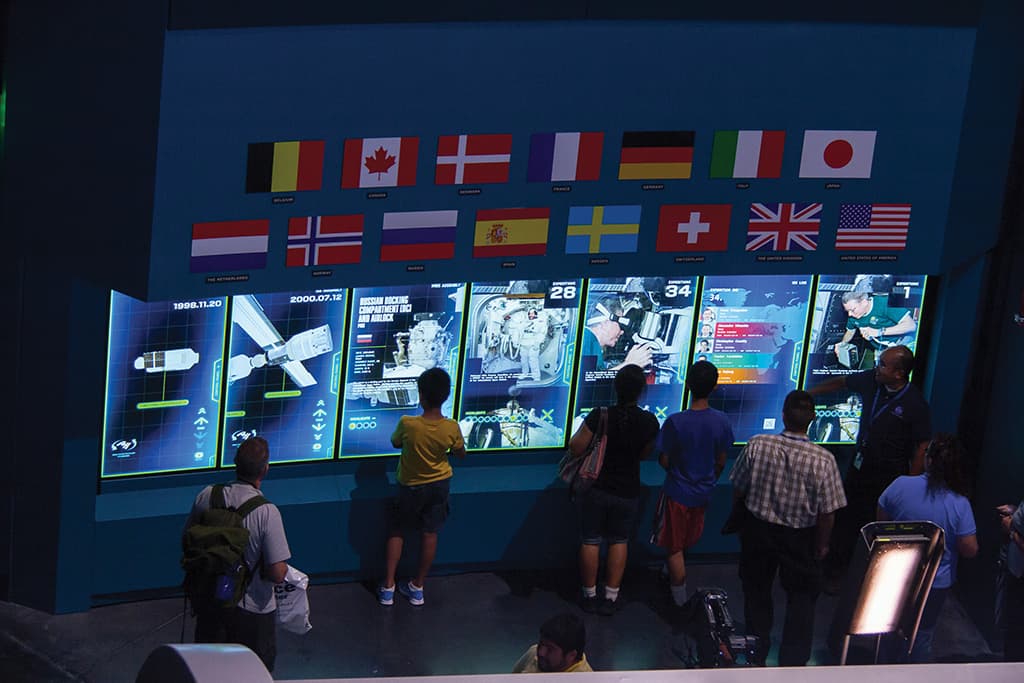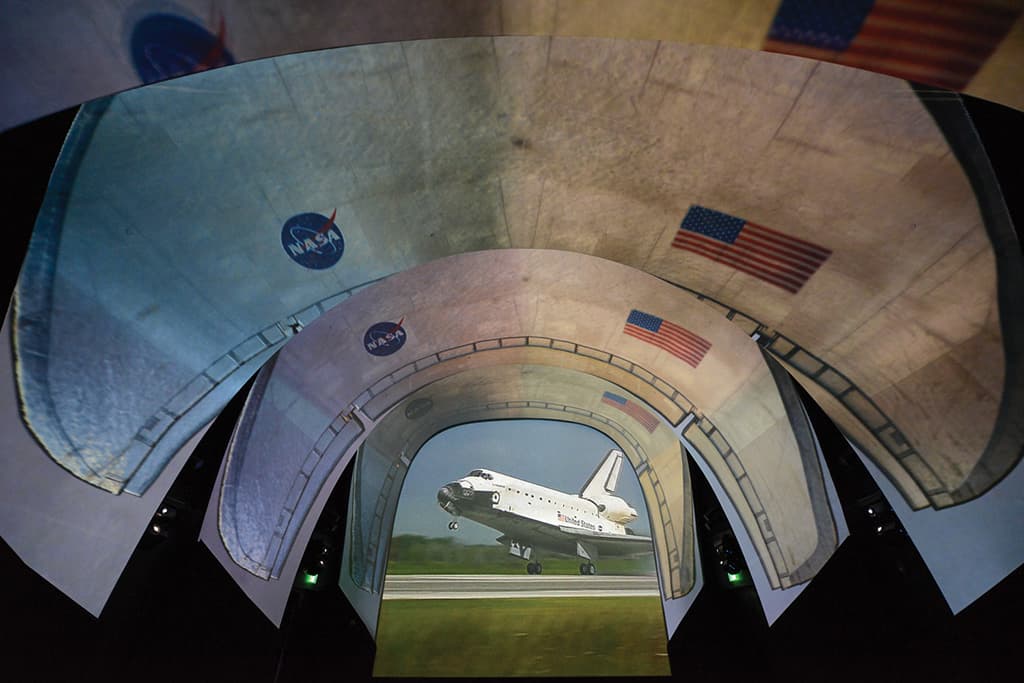
Finding Atlantis
Space shuttle Atlantis returns home to the Kennedy Space Center for the last time.
Text:/ Andy Ciddor
Just like the recently-reported Museum of Australian Democracy at Eureka (MADE), the latest attraction at the Kennedy Space Center (KSC) in Florida is a single-object museum with a great deal of peripheral material to make a visit a worthwhile experience. The experience aspect of the exhibit is very important when you’re asking punters to invest considerable time and effort in travelling to see the show. Ballarat is an hour or so on freeways from Melbourne while KSC is an hour or so down a really boring concrete tollway from the theme parks and tourist ‘attractions’ of Orlando (but there are more alligators to see than on the drive to Ballarat).
At MADE the single object is the Eureka flag, a fragile object of inestimable value, while at KSC the new exhibit is somewhat larger, but valued at just a couple of billion dollars, which, when you think about it, is a reasonable price for a 28-year old vehicle that’s only been driven 33 times and has a mere 203 million kilometres on the clock! In both exhibits the central object doesn’t actually do anything of note, so all of the action has to be through the other exhibits which interpret and describe its meaning to visitors at a wide range of interest and comprehension levels.
SPACE RACE
Although the attraction was still a couple of weeks away from completion when Projectiondesign/Barco very kindly had a small group of us smuggled onto the construction site in hi-viz vests and visitors’ hard hats, it was very clear that this attraction was designed to engage everyone from bored parents to even more easily-bored little brothers and sisters. As someone who’s been fascinated by all things space since the age of six, when my dad showed me the moving star that was earth’s first artificial satellite, Sputnik 1, I was actually a bit saddened and disappointed by some aspects of the exhibit’s design concept. Don’t get me wrong, this is a truly world-class exhibition that uses some of the best techniques around for the presentation of ideas and interactive learning experiences. What upset me was the quarter-scale replica of the International Space Station (ISS) that’s used as a crawling tunnel to amuse the little kids, and the big slippery slide in the shape of the descent curve of the space shuttle returning to earth. I’m sure when I go back to KSC one day with my soon-to-be-born grandson, I’ll appreciate being able to send him off to play on these things while I have a serious play with some of the interactive exhibits, but it just feels a bit tawdry turning all that astounding science and engineering into a slightly fancier version of the climbing frame thing at Macca’s.
Built at a cost of about $100m for Delaware North Companies Parks & Resorts who operates KSC visitors centre for NASA, the 8500sqm space shuttle exhibit is the jewel in the crown of a site that is making the transition from being the base for the USA’s manned space program to yet another of the tourist attractions in the Orlando area, competing with Seaworld, Walt Disney World, Legoland and Universal theme parks.
(above) Atlantis in all its glory, pitched at a 43.21°, complete with mocked-up robotic Canadarm and cargo bay doors supported by FSWR. The small sign near the corner of the cargo bay door was a hasty 11th hour addition when it was realised that an agile teenager could climb on the handrail and onto the door.
Image: Courtesy Kennedy Space Center

SHUTTLE CHOOK RAFFLE
The history of the project is a bit unusual in that it dates back to 2010, when Delaware North and PGAV Destinations, in partnership with NASA, gave PGAV the brief to design and create a space exploration attraction at a time when they didn’t actually have an exhibit to build a museum around. There was a serious shortage of used space shuttles, because some 21 US institutions had put their hands up to be the homes for the four available shuttles: Discovery, Atlantis and Endeavour (the one built from spare parts) which had all flown space missions; plus Enterprise, the flight-test prototype that never went into space.
In April 2011, amidst the flurry of politicking, lobbying and naked influence wielding that is a fine art in US politics, NASA eventually nominated the Smithsonian in Washington, the California Science Center in Los Angeles, and KSC as recipients of the space-faring shuttles, while the Intrepid Sea, Air & Space Museum in New York was allocated Enterprise.
The upshot of this was that over a year into the project not a single piece of building hardware had been purchased, nor a single exhibit been taken beyond concept stage, with only 27 months to go before the opening date: just before the 4th of July weekend in 2013. Actually, they had taken a bit of a gamble and started on some site preparation, which could have been used for another exhibit. Another candidate, the Museum of Flight in Seattle had precipitously started building a wing to house their hoped-for shuttle that never materialised (they did eventually get hold of the full-body mock-up used for astronaut training). Once the announcement had been made, the development at KSC got into full swing, even before Atlantis had left the launch pad on its final mission.

EXHIBITION LAUNCHPAD
Once Atlantis returned to earth it was prepared by NASA for its new life as a museum exhibit by the removal of a substantial proportion of its internal workings, including the extraction of all its pyrotechnically-operated systems, propulsion, batteries, fuel storage and handling, and the draining of a whole range of fluids from hydraulics to coolants. However, the museum doesn’t own Atlantis; it’s only on loan from NASA to Delaware North, who on handover had to sign a receipt for the loan of a $2b space shuttle.
Despite riding into space on a pillar of fire at almost-unbearable acceleration, moving huge pieces of cargo about in space and descending from orbit on layer of white-hot plasma, a space shuttle turns out to be a remarkably fragile vehicle when it’s on the ground and you want to put it on display. Designed as an orbital workhorse, virtually none of its systems were intended to work in the presence of gravity. The magnificent slender Canadian robotic arm which moved vast objects in orbit is too flimsy to even move under gravity – much less support a load – so the arm on display is actually a replica made from ordinary earthbound materials.
OPEN THE POD BAY DOORS HAL?
And so it goes with the cargo bay doors. Whenever these doors were opened for loading before a mission, they were lifted and supported by a special hydraulic jig that kept all load off the hinges and the motors. For display at KSC, the doors had to be lifted open with winches using special support brackets, then carefully supported by a half a dozen static wire rope lines on each side to carefully distribute and support the load that in orbit is handled by something similar in size to a windscreen-wiper motor.
In common with many attractions, on entering the shuttle building visitors are corralled into a holding auditorium and subjected to a multimedia pre-show that provides the historical context for the exhibits they are about to see. Installed and commissioned by AV integrator and master contractor, Electrosonic, the Atlantis pre-show uses four edge-blended Projectiondesign F35 WQXGA (2560 x 1600) projectors to provide an immersive experience, with content being served by individual, multi-head, custom-configured Delta media servers from 7thSense Design. To augment this experience, a further 16 (four groups of four) Projectiondesign F32 projectors in 1920 x 1200 mode provide additional edge-blended video content mapped onto the arches spanning the pre-show space. The show is synchronised via Medialon show control, with sound coming from a predominantly QSC multi-channel audio system and additional audio effects courtesy of TiMax.
At the conclusion of the pre-show, the soundproof screen wall at the front of the auditorium retracts to reveal the space shuttle Atlantis in all its glory, backed by an impressive 37m wide x 4m high LED screen. The visitors then move out through the previously-hidden entrance into the main exhibition hall that houses the Atlantis in orbital mode, a full-scale replica of the Hubble space telescope, a full-scale replica of an ISS, about 60 interactive exhibits and the previously-mentioned items of space-themed play equipment.

SUITING UP
With a 70-tonne object that’s totally static and very fragile as the core of the exhibit, the Atlantis experience needs a lot of supporting material to engage visitors. Interactive exhibit designers Unified Field was contracted to produce a range of exhibits that include touch interactive, augmented reality and simulators. There are two large multi-screen interactive exhibits based around MultiTouch’s 55-inch touchscreen panels. The six-panel Timeline Table provides an interactive history of the development of the shuttle and its various roles as a delivery system for the US space program, including the assembly of the ISS and launch and service the Hubble Space Telescope. The interactive capabilities of the seven-panel ISS Wall include touch-interactive 3D models of the ISS, live and recorded video feeds from the ISS crew and interactive calculators to find the best times to see the ISS pass over the visitor’s home town. The simulators include: an opportunity for visitors to take an astronaut-guided, motion-interactive spacewalk to help assemble the ISS; move objects in space with the shuttle’s robotic Canadarm; dock the shuttle with the ISS; and land the shuttle back on earth.
The label ‘augmented-reality’ is being applied with wild abandon to all sorts of things at the moment, including some of the interactive devices in the Atlantis exhibit. Due to the fragility of the shuttle’s interior on the ground, especially because there is no reason to have a floor to walk on in a vehicle that only operates in the zero gravity of free fall, there is no possibility of visitors being able to physically visit the flight deck and crew quarters. What has been developed instead is a touch monitor on a mounting that allows it to pan and tilt, thus allowing the user to interactively ‘move’ the displayed image around in a virtual space – in this case a series of 360° panoramic images of the shuttle’s interior, captured with NASA’s GigaPan camera, a device developed for Mars exploration. If this idea sounds familiar, it’s because we saw this done by the Melbourne Museum and Megafun with their 2010 Innovation AVIA-winning Panoramic Navigator developed for the Wild exhibition of some 700+ stuffed animals.
No stone has been left unturned in the effort to engage, inform and amuse visitors in this museum of the USA’s spacefaring past. Let’s hope it helps persuade coming generations in the US to once again become a nation with a spacefaring future.
CONTACTS
Kennedy Space Center: www.kennedyspacecenter.com
Hills SVL (Projectiondesign): www.hillssvl.com.au or [email protected]
Interactive Controls (Medialon): (02) 9436 3022 or www.interactivecontrols.com.au
Lightwell (MultiTouch): (02) 9319 0311 or www.lightwell.com.au
Unified Field: www.unifiedfield.com
7thSense Design: www.7thsensedesign.com















RESPONSES